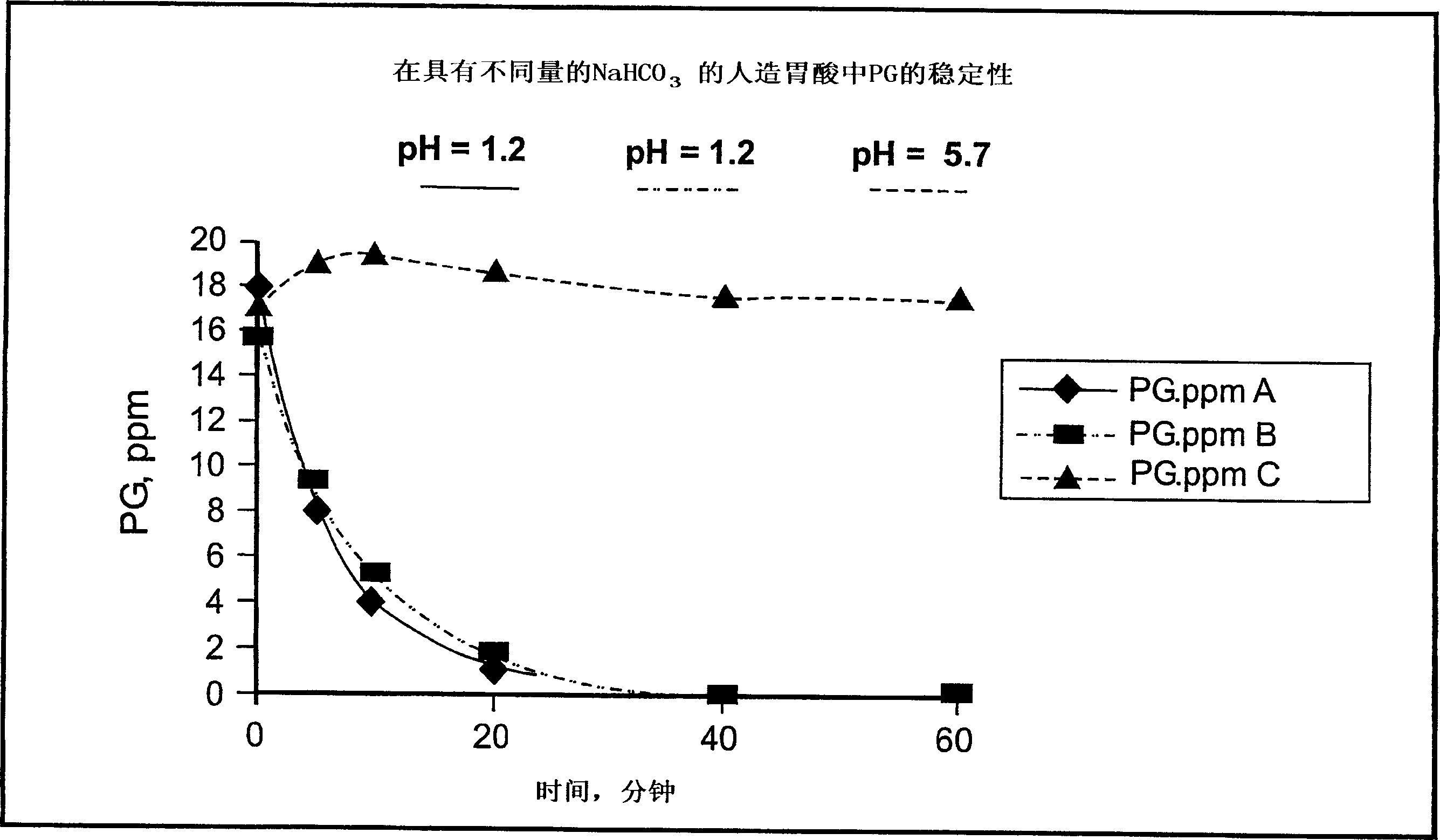Compositions for treating pathologies that necessitate suppression of gastric acid secretion
A composition and drug technology, applied to peptide/protein components, medical preparations containing active ingredients, pharmaceutical formulations, etc.
- Summary
- Abstract
- Description
- Claims
- Application Information
AI Technical Summary
Problems solved by technology
Method used
Image
Examples
Embodiment 1
[0092] Example 1: NaHCO 3 Maintain the stability of PG in artificial gastric juice
[0093] In Vitro Determination of NaHCO Using Artificial Gastric Juice 3 Stability of PG in the presence of acidic pH. Artificial gastric juice was prepared according to page 235 of the United States Pharmacopoeia (USP) 2000 edition. To prepare 200 ml of gastric juice, 0.4 g of NaCl and 0.64 g of pepsin were dissolved in 16 ml of 1M HCl and 184 ml of water. The pH of gastric juice is 1.2. 10 or 20ml of 8.4% (1M) NaHCO 3 (3.72 mg / ml or 7.12 mg / ml final concentration, respectively) and 16 ml of 250 ppm PG solution (0.25 mg / ml) were added to the solution. The concentration of PG in the final solution was 16 ppm. When indicated, omeprazole granules were also added (solutions B and C). To determine the stability of PG in the final solution over time, HPLC analysis was performed on samples taken at the following time points after preparation: 0' (immediately after preparation), 5', 10', 20', 4...
Embodiment 2
[0096] Example 2: Compression-coated or bilayer tablet containing PG, non-enteric-coated-omeprazole, sodium bicarbonate and calcium carbonate
[0097] Omeprazole (powder)
[0098] Compression-coated or bi-layer tablets are prepared in a two-step process. For single tablets, 4 mg PG, 250 mg calcium carbonate and microcrystalline cellulose were mixed and pre-compressed into the first layer of the tablet. The PG containing layer was further coated with a thin layer of HPMC which allowed a delayed release of PG from the tablet for 10-15 minutes. For the second layer, 40 mg of non-enteric coated-omeprazole powder was combined with 500 mg of NaHCO 3 , 250mg CaCO 3 And a suitable adhesive is compressed onto the PG layer to form the second layer of the tablet. The second layer of the tablet breaks down immediately after degradation to release omeprazole rapidly. A schematic diagram of a bilayer tablet containing PG, non-enteric coated omeprazole, sodium bicarbonate and c...
Embodiment 3
[0099] Example 3: Rapidly Disintegrating Tablets Containing PG, Non-Enteric Coated-Omeprazole, Sodium Bicarbonate and Calcium Carbonate
[0100] Omeprazole (powder)
[0101] Mix non-enteric coated omeprazole (40mg), PG (4mg), NaHCO 3 , CaCO 3 , croscarmellose sodium, microcrystalline cellulose and magnesium stearate and the resulting mixture compressed into tablets using a standard tablet press to yield rapidly disintegrating tablets (intravescent).
PUM
 Login to View More
Login to View More Abstract
Description
Claims
Application Information
 Login to View More
Login to View More - R&D
- Intellectual Property
- Life Sciences
- Materials
- Tech Scout
- Unparalleled Data Quality
- Higher Quality Content
- 60% Fewer Hallucinations
Browse by: Latest US Patents, China's latest patents, Technical Efficacy Thesaurus, Application Domain, Technology Topic, Popular Technical Reports.
© 2025 PatSnap. All rights reserved.Legal|Privacy policy|Modern Slavery Act Transparency Statement|Sitemap|About US| Contact US: help@patsnap.com



